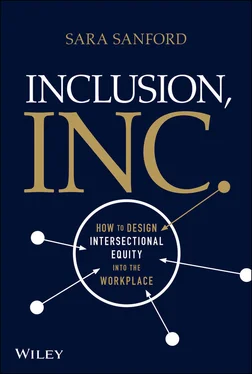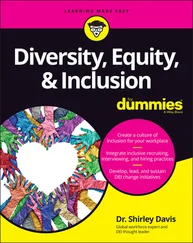7 7.Laura Morgan Roberts and Anthony J. Mayo, “Toward a Racially Just Workplace,” Harvard Business Review, November 14, 2019, https://hbr.org/2019/11/toward-a-racially-just-workplace.
8 8.Martin Abel, “Why Female Bosses Get Different Reactions Than Men When They Criticize Employees,” The Conversation, September 10, 2020, https://theconversation.com/why-female-bosses-get-different-reactions-than-men-when-they-criticize-employees-145970.
9 9.Evan W. Carr, Andrew Reece, Gabriella Rosen Kellerman, and Alexi Robichaux, “The Value of Belonging at Work,” Harvard Business Review, December 16, 2019, https://hbr.org/2019/12/the-value-of-belonging-at-work.
10 10.Frank Dobbin, Daniel Schrage, and Alexandra Kalev, “Rage Against the Iron Cage: The Varied Effects of Bureaucratic Personnel Reforms on Diversity,” American Sociological Review 80, no. 5 (2015): 1014–1044, doi: 10.1177/0003122415596416.
11 11.Frank Dobbin and Alexandra Kalev, “Why Diversity Programs Fail,” Harvard Business Review, July–August 2016, https://hbr.org/2016/07/why-diversity-programs-fail.
12 12.Erica Goode, “At Energy-Minded U.S. Hotels, They'll Turn the Lights Off for You,” New York Times, May 9, 2016, https://www.nytimes.com/2016/05/10/business/hotel-energy-efficiency-carbon-footprint.html.
13 13.Wikipedia, s.v. “List of Cognitive Biases,” last modified July 14, 2021, 14:01 (UTC), https://en.wikipedia.org/wiki/List_of_cognitive_biases.
14 14.Hannah Valantine, “The Science of Diversity and the Impact of Implicit Bias,” National Institutes of Health, 2017, https://diversity.nih.gov/sites/coswd/files/images/2017-12/implicit_bias_talk_for_toolkit_pdf_508c_0.pdf.
15 15.Kathleen Melymuka, “Why Women Quit Technology,” Computerworld, June 16, 2008, https://www.computerworld.com/article/2551969/it-careers-why-women-quit-technology.html.
16 16.The term “Weapons of Math Destruction” was coined by former Wall Street quantitative analyst and current mathematician, data scientist, author, and data ethicist Cathy O'Neil.
CHAPTER 2 “But We've Always Done It This Way…”
I am biased against women in leadership.
Specifically, I associate men with leadership and career, and women with family.
At least, that's what the Harvard Implicit Association Test told me. 1 And, as the creators of the test recommend in their book, The Blind Spot , I took the test more than once. All six times that I took an iteration of the test, the result was the same: I harbor a strong unconscious bias against women in leadership roles.
If you asked me if I believe women belong in leadership roles, I would confidently answer yes. But, if forced to quickly pair masculine- and feminine-associated terms (man, woman, Mr., Ms.) with domains such as leadership, career, or family, my unconscious is firmly stuck in a biased rut.
Discovering this bias after taking the first test didn't make me any better at suppressing it in the retakes. My unconscious biases overrode my willpower, every single time.
Seated in our amygdala, our unconscious mind drives up to 95 percent of our decision-making. 2 If you've ever attended a training on unconscious bias, you've probably heard how our biases are interwoven with an unconscious recognition of patterns, a scheme whose purpose is to keep us safe from potential threats. This combination of sensory perception and unconscious interpretation signals to us how we should respond to our surroundings, including who we should regard as friend or foe.
This unconscious self-defense system keeps ticking away when we go to work, influencing who we associate with, who we think of as capable, and who we do—or don't—value.
Understanding how ever-present and influential our biases are is key to understanding why current approaches to DEI aren't working.
But the Bias—Is It Really That Bad?
In 2014, the United States Institute for Peace partnered with the Geena Davis Institute to release a study on gender in media. Part of the study involved observing people in large groups, and researchers witnessed a bizarre behavior: When women made up 17 percent of a group, men estimated that they actually made up 50 percent of the group. Once a crowd was 33 percent female, women were perceived as the majority. 3 The study's participants, however, did not overestimate the presence of men in large groups.
When typically underrepresented individuals are in spaces where we're not used to seeing them, we tend to overestimate their presence. A female minority, for example, can seem like a female majority in a space that is typically male-dominated.
Most of us don't have to estimate the number of people in groups at work, but our perceptions of others' behaviors can be influenced by what we're used to seeing and have come to expect. For example, while women have been stereotyped as talking more than men, multiple studies have found that they spend less time than men talking in meetings. Their comments are shorter, and they are interrupted more often. One study found that women needed to make up 60 to 80 percent of a group before they used as much speaking time, collectively, as men in the conversation. Another now-classic study recorded university faculty meetings and found that, with one exception, the men at the meetings spoke more often, and without exception, spoke longer. 4 The longest comment by a woman at all seven gatherings was shorter than the shortest comment by a man. In online discussions on professional topics, messages written by men have been found to be, on average, twice as long as those written by women. 5
And despite this, our perceptions of women as “chatty” remain. As stated in a PBS summary of research on gender and language, “[In] seminars and debates, when women and men are deliberately given an equal amount of the highly valued talking time, there is often a perception that [women] are getting more than their fair share.” 6
Because a gender-balanced workforce is a fairly new phenomenon, female voices can be heard as more present than they actually are. Even when we believe we're comparing the talking time of women to that of men, we're unconsciously comparing the talking time of women now to the talking time of women in the past .
Our perceptions of the ways people behave are built on a baseline of the ways we expect them to behave, and these differences impact how we treat people. Anything exceeding our expectations or past experiences feels extreme, and we push back against it. These unconscious expectations—the norms our amygdala clings to—sabotage one of the common approaches to DEI that has gained momentum over the last few years: leaning in .
Lean In: The Self-Empowerment Paradox
In 2013, the term “lean in” became the rallying cry of (mostly white) women looking to climb the corporate ladder and smash the glass ceiling. Sheryl Sandberg popularized the self-empowerment slogan in her monumental bestseller, Lean In: Women, Work, and the Will to Lead .
Initially, I was one of her early devotees. When the book came out, I was feeling stuck, but still ambitious. I wanted to be taken seriously.
Her book seemed to provide answers. If there wasn't a seat for me at the table, I was going to bring a folding chair! If someone spoke over me in a meeting, I was going to insist on finishing my point. I was going to practice The Shine Theory and highlight the work of other women in the office.
Most daunting: I was going to renegotiate my salary.
I unearthed my copy of Lean In recently and discovered that I had highlighted the entire section that gives tactical advice on ways women can negotiate and still be seen as “likable” enough for their peers to keep wanting to work with them. At the time of my Lean In enthusiasm, my employer was about to be acquired by another company, giving me an opening to renegotiate my role. I was going to pitch myself for a new position, with a new title and a specific salary. I had memorized all of Sandberg's one-liners. I substituted “we” for “I,” because a woman will still be seen as communal if she asserts, “We had a great year,” as opposed to “I had a great year.” I visualized the conversation, including how I would counter potential objections.
Читать дальше












